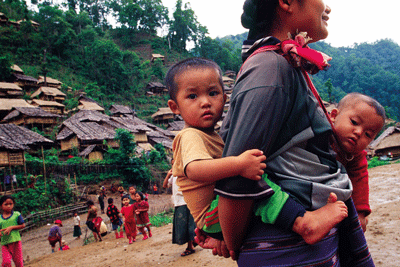
| By YENI | Thursday, October 1, 2009 |
Most Karen refugees hope to return to Burma one day
Holding the youngest of her four grandchildren in her arms, 60-year-old Bi Mae said: “If there is peace again, we will go back to our village.”
Bi Mae and the four children fled to Thailand in July to escape the fighting in her Karen homeland, together with more than 500 other refugees.
Their home now is a makeshift bamboo hut in a temporary refugee camp at Tha Song Yang near the Thai-Burmese border. Since the beginning of June, fierce clashes between a joint force of Burmese government troops and their local allies, the Democratic Karen Buddhist Army (DKBA), and their traditional foe, the Karen National Liberation Army (KNLA), have forced around 4,000 Karen villagers to flee to Thailand.
 |
| A Karen woman brings her children to a ceremony marking International Refugee Day at Mae La Oon camp. (Photo: MASARU GOTO/TBBC) |
They boosted the number of refugees admitted to camps along the Thai-Burmese border to 134,000. A further 50,000 have been resettled in the US and other Western countries. Most of those still in the camps dream of being able to return home to Burma one day.
For many long-time residents of the camps, the dream has faded. The flow of refugees into Thailand began a generation ago, in 1984, when Burmese government forces began a push into Karen rebel-held territory, uprooting 10,000 villagers and forcing them to seek safety across the nearby Thai border.
The first arrived in January 1984, crossing the Moei River into Thailand’s Tak Province and setting up camp there.
Although Thailand was not—and is still not—a signatory to UN conventions on refugees, it agreed to give shelter to the desperate Karen, following an independent humanitarian policy that it had also applied for several years to refugees from Cambodia, Laos and Vietnam. In 1984, it was already hosting some 350,000 refugees.
In February 1984, under increasing pressure to provide the Karen with food and shelter, the Thai Ministry of the Interior turned for help to voluntary agencies working with Cambodian, Laotian and Vietnamese refugees on Thailand’s eastern border.
The agencies, grouped together as the Committee for Coordination of Services to Displaced Persons in Thailand, (CCSDPT) quickly responded and sent a mission to organize food supplies.
Like the Karen refugees themselves, the agencies and the Thai government thought the new arrivals from Karen State would soon be able to return to their homes.
The crisis spread, however, and Mon refugees were soon arriving across Thailand’s southern border with Burma, bringing with them horrifying accounts of abuses by the Burmese government soldiers—razed villages, rape, torture, summary execution, forced labor.
International agencies such as the Office of the United Nations High Commissioner for Refugees (UNHCR) could only look on, powerless to assist the displaced and terrorized villagers on Burmese territory.
Four years later, in August 1988, events took a further dramatic turn when Burma was rocked by a national uprising. The regime’s brutal suppression of the protests sent hundreds of thousands of students and other young activists into hiding in the jungles along the Thai-Burmese border.
Many made their way to Bangkok to seek asylum, claiming refugee status under the UNHCR mandate. The refugees generally fell into two UNHCR categories—“persons fleeing fighting,” primarily ethnic Karen, Karenni and Mon, and “persons of concern,” principally ethnic people who do not feel safe at the border as well as Burmese political exiles, dissidents and student activists.
Logging contracts and other business deals between the new Burmese military regime that took power in 1988 and Thai military leaders, which were intended to create “markets from battlefields,” only increased border tensions. Bangkok abandoned its longstanding policy of tolerating Karen rebels, who had acted as a kind of buffer zone between Thailand and Burma—and Burmese government forces stepped up their presence along the Thai-Burmese border
In 1989, fierce fighting in Karenni State sent a first large influx of refugees into Mae Hong Song Province in northern Thailand.


Thailand Hotels
Bangkok Hotels
China Hotels
India Hotels

|
